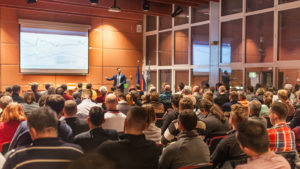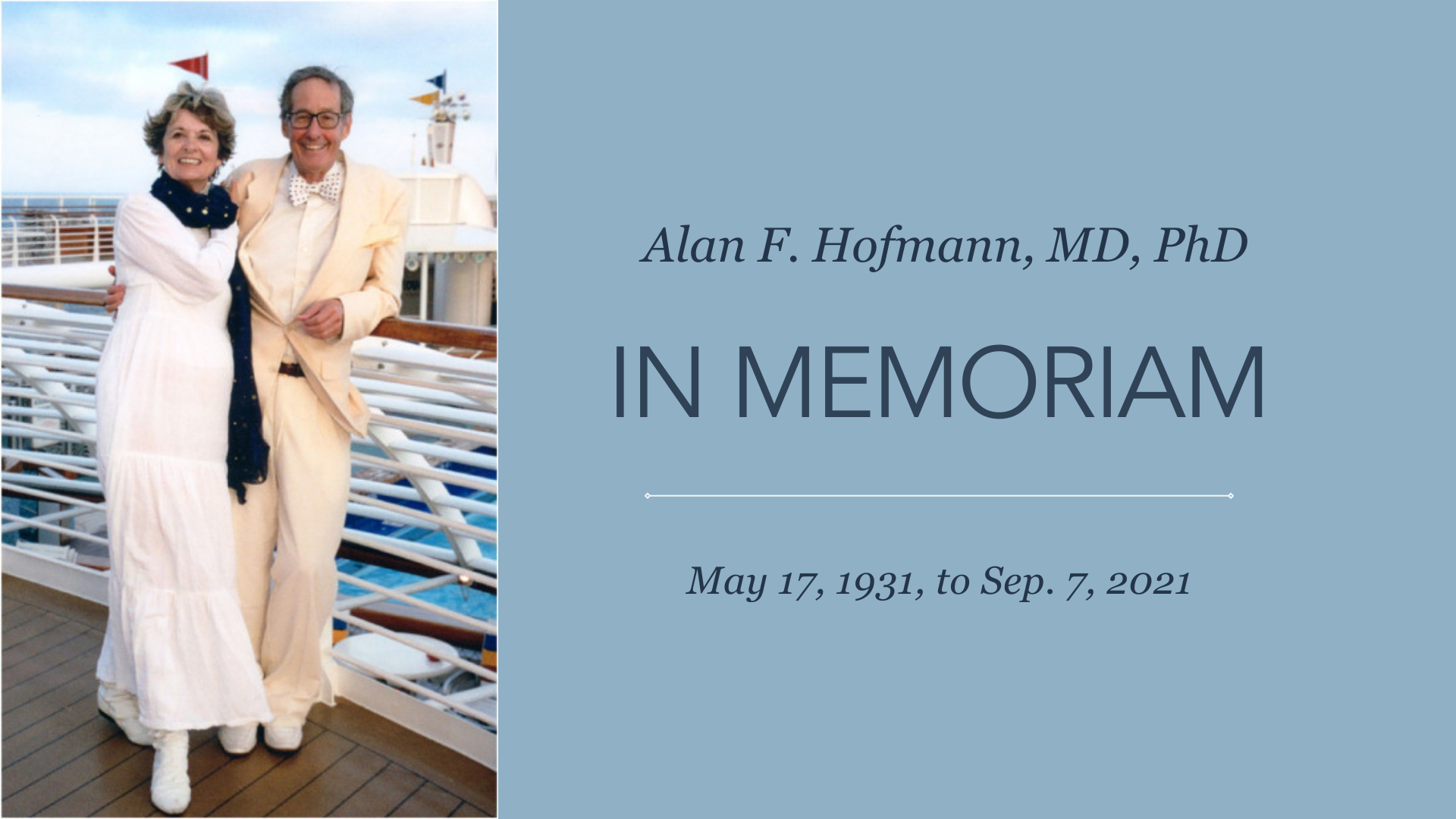This article first appeared in Gastroenterology and was authored by Kim E. Barrett, PhD, and Nicholas F. LaRusso, MD.
The fields of gastroenterology and hepatology lost a true legend when Alan Hofmann died peacefully at his La Jolla home on Sep. 7, 2021, surrounded by family, and after a period battling multiple system atrophy. He was 90 years old. Alan was recognized as one of the world’s leading researchers on the chemistry, physiology and the clinical significance of bile acids. Originally considered simply as biological detergents that aid in the solubilization of dietary and endogenous lipids, Alan lived to see these molecules receive their full recognition as multifaceted biological signals that variously regulate gene transcription, the microbiome, fluid and electrolyte homeostasis and many more aspects of biology that are still being uncovered.
Alan was born in Baltimore, Maryland, in modest circumstances that clearly informed his later approach to his life, career and interactions with fellow humans. Despite the fact that his father was forced to leave school at the age of 12 to work, Alan’s brilliant intellect was recognized early on and garnered a scholarship to Johns Hopkins University (JHU) for his undergraduate education. Summers were spent driving a Good Humor ice-cream truck, providing material that underpinned numerous later anecdotes. Johns Hopkins also supported Alan’s subsequent medical education, generosity for which Alan remained extremely grateful throughout his life and led him to endow an annual lectureship in the JHU gastroenterology division. He completed his residency in Internal Medicine at Columbia–Presbyterian in New York, where, ever resourceful, he also obtained his Ship’s Surgeon license allowing him to earn additional funds. He next undertook a research project at the National Heart Institute on the absorption of olive oil that set the direction of his future career, but then had the opportunity to join the National Symphony on a goodwill Pan-American tour as the orchestra’s physician. While in Peru, he learned that a proposal he had submitted to the National Foundation was funded, which allowed him to travel to the University of Lund, Sweden, for 3 years to work with Bengt Borgström. Together, they worked out the principles of micellar solubilization both in model systems and by aspirating intestinal contents from human volunteers. At the end of his fellowship, and with a research thesis completed, he returned to New York as a Research Associate and subsequently to an Assistant Professor position at the Rockefeller University. He continued to study lipid homeostasis, defining the pathways of hepatic and intestinal cholesterol excretion.
In 1966, Alan was recruited to the Mayo Clinic in Rochester with the promise that his sole responsibility would be to conduct research; Nicholas F. LaRusso had the great privilege of being one of his fellows. During this period, he and his colleagues John Thistle and Les Schoenfield discovered that feeding of chenodeoxycholic acid could lower cholesterol excretion and also result in the gradual dissolution of gallstones. Thus, although he was no longer engaged directly in clinical work, his focus nevertheless continuously returned to an understanding of how the basic biology he was uncovering could be used in treatment. Throughout his career, in fact, he was sought out as a consultant by numerous companies and saw his experimental treatments, including the use of chenodeoxycholic acid, translated to practice. In 1977, Alan was invited by his Mayo colleague, Bill Summerskill, to join him and head up research in the nascent Division of Gastroenterology forming at the University of California San Diego. Despite Bill’s untimely death before he could move to San Diego, Alan was seduced by the beauty of La Jolla and decided to make the move to UC San Diego anyway, which was to become his final academic home.
Perhaps the most important decision that Alan made on moving to UC San Diego was to emphasize the chemistry as well as the biology of bile acids in his new laboratory, adding synthetic chemists to his team. This increased the extent to which his work underpinned new drugs based on bile acids, and directly contributed to the development, for example, of obeticholic acid for the treatment of primary biliary cholangitis. Alan also became deeply involved in the preclinical education of medical, and later pharmacy, students as a key faculty member for the GI section of the Organ Physiology course; Kim E. Barrett later joined him in this responsibility. It is likely accurate to state that the health professional students at UCSD during Alan’s tenure knew more about bile acids and biliary physiology than any others in the country, and many of the small group exercises that Alan devised are still in use even as the school moved to an organ-based curriculum after his retirement. Alan was undoubtedly a vividly memorable lecturer whether teaching or talking about his research, with his passion always on display and a knack for persuasive visual aids that predated the eras of PowerPoint and BioRender. Indeed, he made critical contributions to the American Gastroenterological Association’s Undergraduate Teaching Project that provided outstanding resources for medical education for many years.
Alan received many honors for his work, including an honorary degree from the University of Bologna, the Herbert Falk medal, the Thannhauser medal, and awards from many professional societies, the Mayo Clinic and JHU. From the American Gastroenterological Association, he received the trifecta of the Distinguished Achievement Award (1970), the Beaumont Prize (1979), and the Julius Friedenwald Medal (1994).
On a personal level, Alan was the ideal colleague — brimming with ideas, generous with his time, always seeking opportunities to serve as a mento and genuinely delighted with the successes of others, whether they were members of his own group or beyond. Kim E. Barrett had an office two doors down the hallway from Alan for the initial 20 years of her career, and clearly recalls his great pleasure on learning that her first NIH grant would be funded; they went on to share a number of projects and publications. Likewise, numerous individuals throughout the world who have ascended to positions of prominence in bile acid research specifically, or in gastroenterology and hepatology more generally, credit Alan’s major influence on their careers. For example, former trainee Susan Cummings called him “the single most influential person (other than parents) in my life” and dubbed Alan “a kind genius.” A Zoom-based celebration of Alan’s life and career shortly after his death that was organized by Stephen Keely and Julian Walters drew more than 50 attendees, despite the challenge of time zones, and extended for more than 2.5 hours to accommodate all who wished to share their memories.












